fuse CADILLAC CTS 2006 1.G Owners Manual
[x] Cancel search | Manufacturer: CADILLAC, Model Year: 2006, Model line: CTS, Model: CADILLAC CTS 2006 1.GPages: 442, PDF Size: 2.57 MB
Page 11 of 442
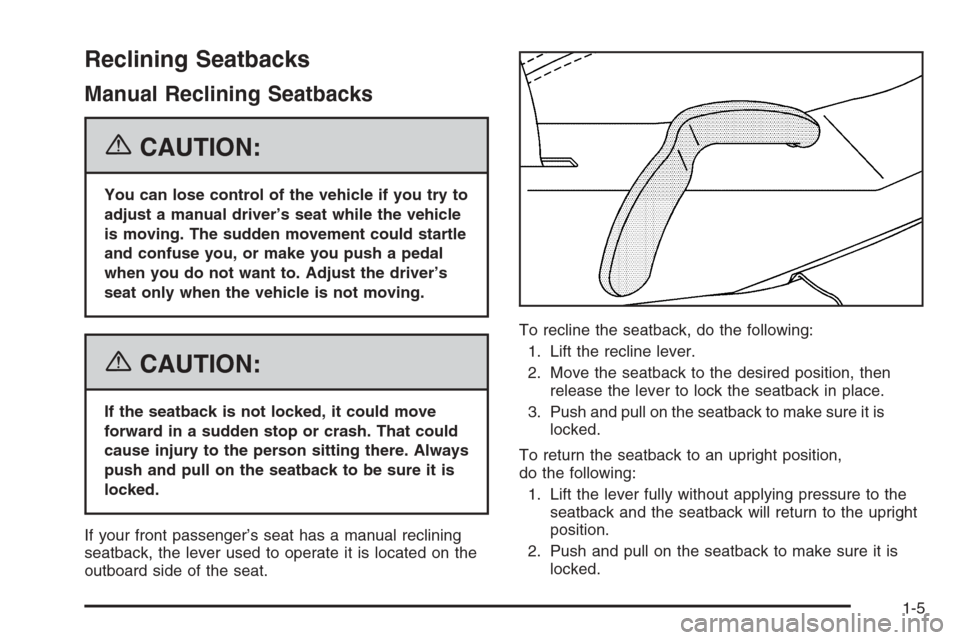
Reclining Seatbacks
Manual Reclining Seatbacks
{CAUTION:
You can lose control of the vehicle if you try to
adjust a manual driver’s seat while the vehicle
is moving. The sudden movement could startle
and confuse you, or make you push a pedal
when you do not want to. Adjust the driver’s
seat only when the vehicle is not moving.
{CAUTION:
If the seatback is not locked, it could move
forward in a sudden stop or crash. That could
cause injury to the person sitting there. Always
push and pull on the seatback to be sure it is
locked.
If your front passenger’s seat has a manual reclining
seatback, the lever used to operate it is located on the
outboard side of the seat.To recline the seatback, do the following:
1. Lift the recline lever.
2. Move the seatback to the desired position, then
release the lever to lock the seatback in place.
3. Push and pull on the seatback to make sure it is
locked.
To return the seatback to an upright position,
do the following:
1. Lift the lever fully without applying pressure to the
seatback and the seatback will return to the upright
position.
2. Push and pull on the seatback to make sure it is
locked.
1-5
Page 95 of 442
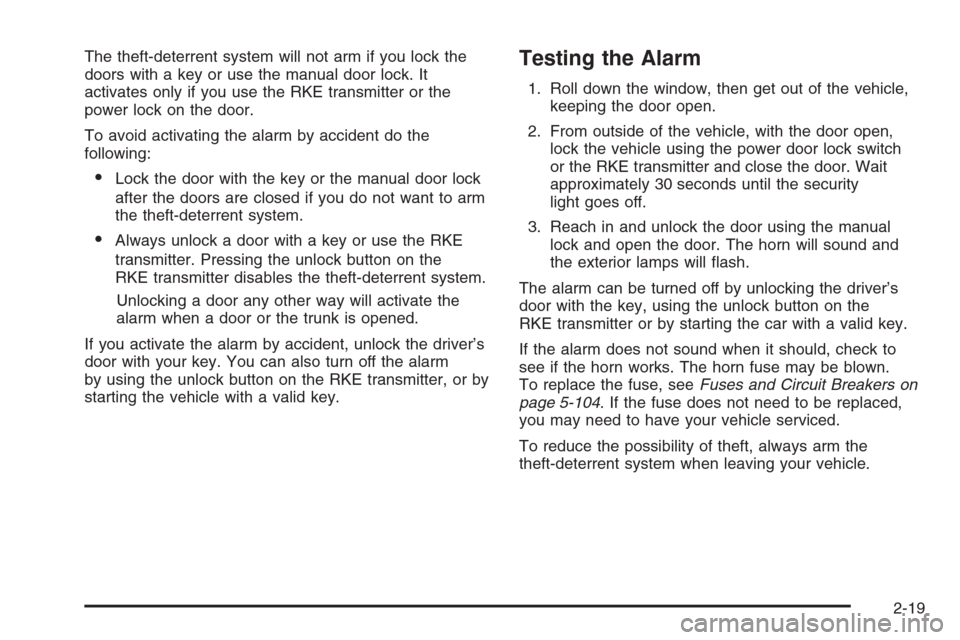
The theft-deterrent system will not arm if you lock the
doors with a key or use the manual door lock. It
activates only if you use the RKE transmitter or the
power lock on the door.
To avoid activating the alarm by accident do the
following:
Lock the door with the key or the manual door lock
after the doors are closed if you do not want to arm
the theft-deterrent system.
Always unlock a door with a key or use the RKE
transmitter. Pressing the unlock button on the
RKE transmitter disables the theft-deterrent system.
Unlocking a door any other way will activate the
alarm when a door or the trunk is opened.
If you activate the alarm by accident, unlock the driver’s
door with your key. You can also turn off the alarm
by using the unlock button on the RKE transmitter, or by
starting the vehicle with a valid key.
Testing the Alarm
1. Roll down the window, then get out of the vehicle,
keeping the door open.
2. From outside of the vehicle, with the door open,
lock the vehicle using the power door lock switch
or the RKE transmitter and close the door. Wait
approximately 30 seconds until the security
light goes off.
3. Reach in and unlock the door using the manual
lock and open the door. The horn will sound and
the exterior lamps will �ash.
The alarm can be turned off by unlocking the driver’s
door with the key, using the unlock button on the
RKE transmitter or by starting the car with a valid key.
If the alarm does not sound when it should, check to
see if the horn works. The horn fuse may be blown.
To replace the fuse, seeFuses and Circuit Breakers on
page 5-104. If the fuse does not need to be replaced,
you may need to have your vehicle serviced.
To reduce the possibility of theft, always arm the
theft-deterrent system when leaving your vehicle.
2-19
Page 97 of 442
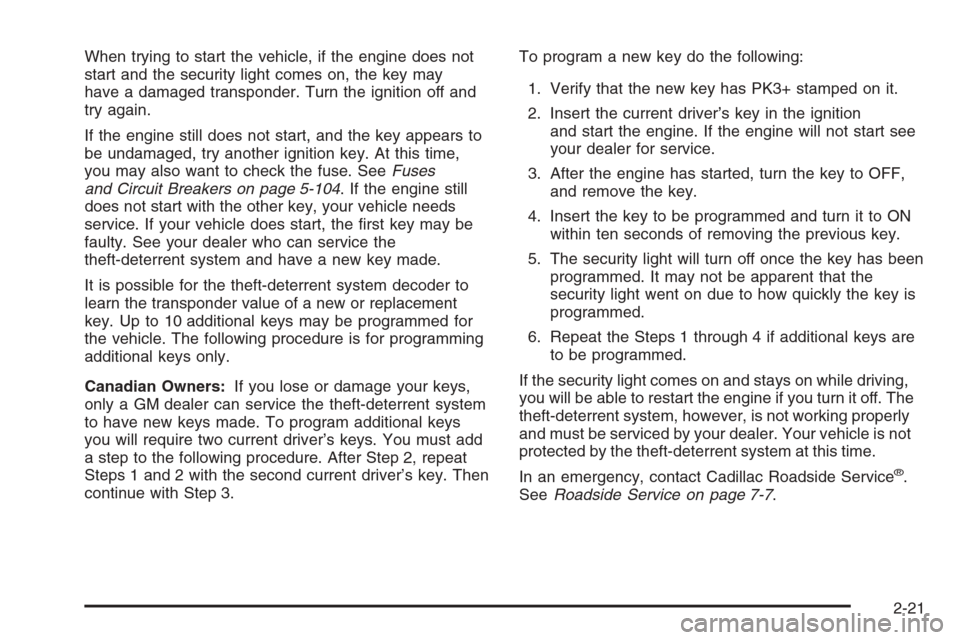
When trying to start the vehicle, if the engine does not
start and the security light comes on, the key may
have a damaged transponder. Turn the ignition off and
try again.
If the engine still does not start, and the key appears to
be undamaged, try another ignition key. At this time,
you may also want to check the fuse. SeeFuses
and Circuit Breakers on page 5-104. If the engine still
does not start with the other key, your vehicle needs
service. If your vehicle does start, the �rst key may be
faulty. See your dealer who can service the
theft-deterrent system and have a new key made.
It is possible for the theft-deterrent system decoder to
learn the transponder value of a new or replacement
key. Up to 10 additional keys may be programmed for
the vehicle. The following procedure is for programming
additional keys only.
Canadian Owners:If you lose or damage your keys,
only a GM dealer can service the theft-deterrent system
to have new keys made. To program additional keys
you will require two current driver’s keys. You must add
a step to the following procedure. After Step 2, repeat
Steps 1 and 2 with the second current driver’s key. Then
continue with Step 3.To program a new key do the following:
1. Verify that the new key has PK3+ stamped on it.
2. Insert the current driver’s key in the ignition
and start the engine. If the engine will not start see
your dealer for service.
3. After the engine has started, turn the key to OFF,
and remove the key.
4. Insert the key to be programmed and turn it to ON
within ten seconds of removing the previous key.
5. The security light will turn off once the key has been
programmed. It may not be apparent that the
security light went on due to how quickly the key is
programmed.
6. Repeat the Steps 1 through 4 if additional keys are
to be programmed.
If the security light comes on and stays on while driving,
you will be able to restart the engine if you turn it off. The
theft-deterrent system, however, is not working properly
and must be serviced by your dealer. Your vehicle is not
protected by the theft-deterrent system at this time.
In an emergency, contact Cadillac Roadside Service
®.
SeeRoadside Service on page 7-7.
2-21
Page 102 of 442
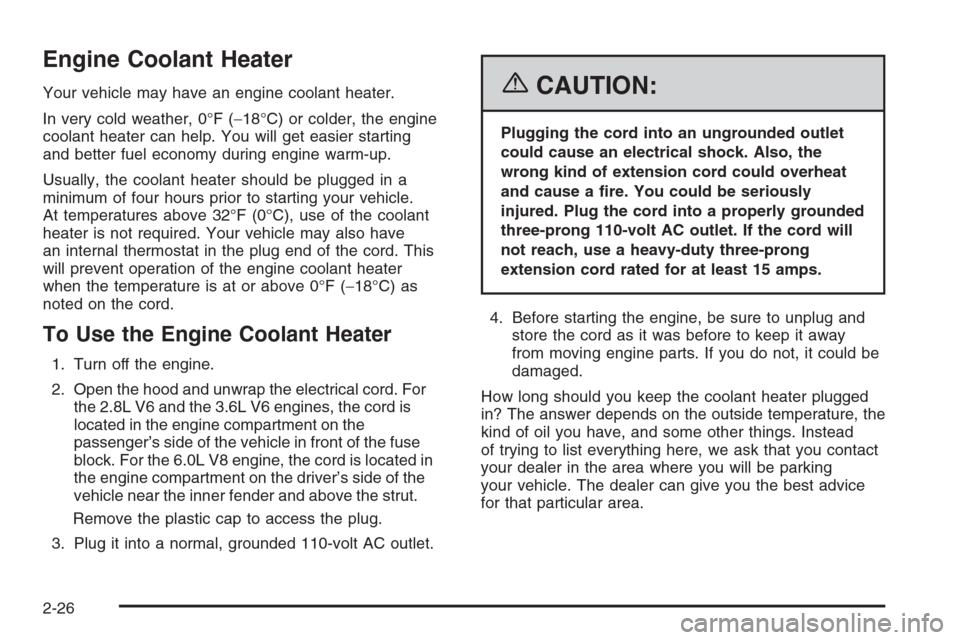
Engine Coolant Heater
Your vehicle may have an engine coolant heater.
In very cold weather, 0°F (−18°C) or colder, the engine
coolant heater can help. You will get easier starting
and better fuel economy during engine warm-up.
Usually, the coolant heater should be plugged in a
minimum of four hours prior to starting your vehicle.
At temperatures above 32°F (0°C), use of the coolant
heater is not required. Your vehicle may also have
an internal thermostat in the plug end of the cord. This
will prevent operation of the engine coolant heater
when the temperature is at or above 0°F (−18°C) as
noted on the cord.
To Use the Engine Coolant Heater
1. Turn off the engine.
2. Open the hood and unwrap the electrical cord. For
the 2.8L V6 and the 3.6L V6 engines, the cord is
located in the engine compartment on the
passenger’s side of the vehicle in front of the fuse
block. For the 6.0L V8 engine, the cord is located in
the engine compartment on the driver’s side of the
vehicle near the inner fender and above the strut.
Remove the plastic cap to access the plug.
3. Plug it into a normal, grounded 110-volt AC outlet.
{CAUTION:
Plugging the cord into an ungrounded outlet
could cause an electrical shock. Also, the
wrong kind of extension cord could overheat
and cause a �re. You could be seriously
injured. Plug the cord into a properly grounded
three-prong 110-volt AC outlet. If the cord will
not reach, use a heavy-duty three-prong
extension cord rated for at least 15 amps.
4. Before starting the engine, be sure to unplug and
store the cord as it was before to keep it away
from moving engine parts. If you do not, it could be
damaged.
How long should you keep the coolant heater plugged
in? The answer depends on the outside temperature, the
kind of oil you have, and some other things. Instead
of trying to list everything here, we ask that you contact
your dealer in the area where you will be parking
your vehicle. The dealer can give you the best advice
for that particular area.
2-26
Page 139 of 442
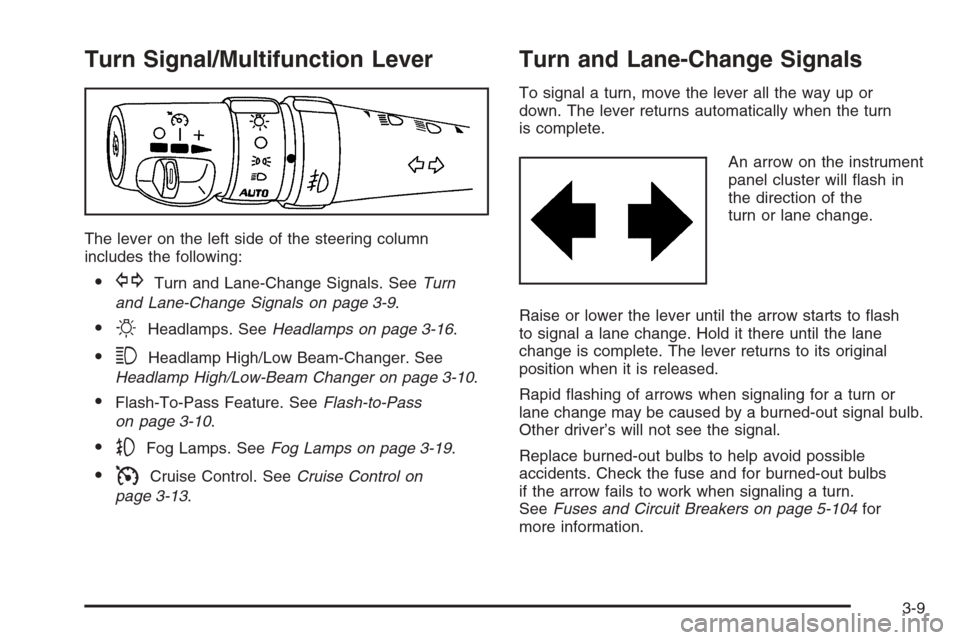
Turn Signal/Multifunction Lever
The lever on the left side of the steering column
includes the following:
GTurn and Lane-Change Signals. SeeTurn
and Lane-Change Signals on page 3-9.
OHeadlamps. SeeHeadlamps on page 3-16.
3Headlamp High/Low Beam-Changer. See
Headlamp High/Low-Beam Changer on page 3-10.
Flash-To-Pass Feature. SeeFlash-to-Pass
on page 3-10.
-Fog Lamps. SeeFog Lamps on page 3-19.
ICruise Control. SeeCruise Control on
page 3-13.
Turn and Lane-Change Signals
To signal a turn, move the lever all the way up or
down. The lever returns automatically when the turn
is complete.
An arrow on the instrument
panel cluster will �ash in
the direction of the
turn or lane change.
Raise or lower the lever until the arrow starts to �ash
to signal a lane change. Hold it there until the lane
change is complete. The lever returns to its original
position when it is released.
Rapid �ashing of arrows when signaling for a turn or
lane change may be caused by a burned-out signal bulb.
Other driver’s will not see the signal.
Replace burned-out bulbs to help avoid possible
accidents. Check the fuse and for burned-out bulbs
if the arrow fails to work when signaling a turn.
SeeFuses and Circuit Breakers on page 5-104for
more information.
3-9
Page 152 of 442
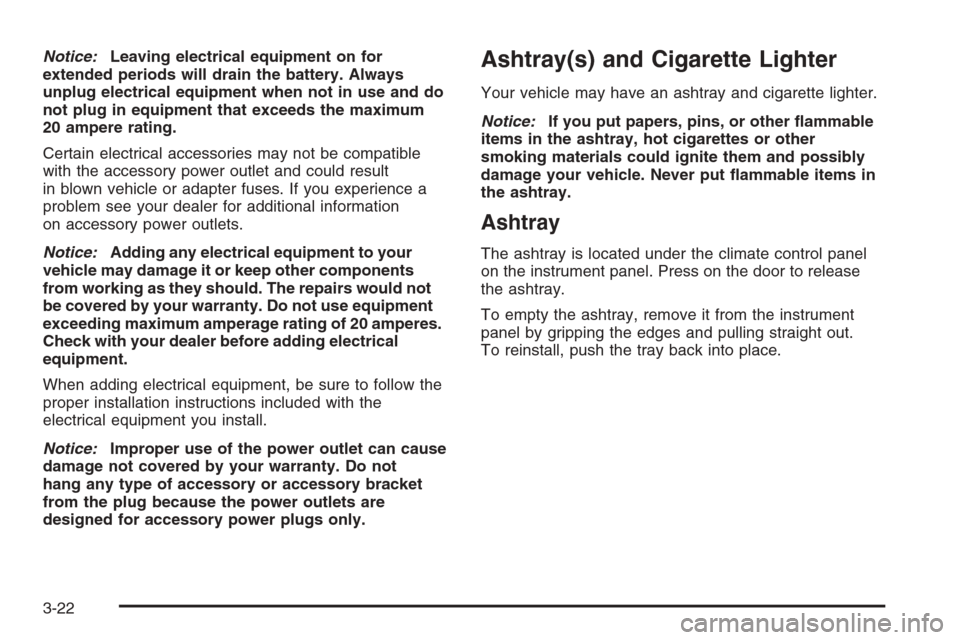
Notice:Leaving electrical equipment on for
extended periods will drain the battery. Always
unplug electrical equipment when not in use and do
not plug in equipment that exceeds the maximum
20 ampere rating.
Certain electrical accessories may not be compatible
with the accessory power outlet and could result
in blown vehicle or adapter fuses. If you experience a
problem see your dealer for additional information
on accessory power outlets.
Notice:Adding any electrical equipment to your
vehicle may damage it or keep other components
from working as they should. The repairs would not
be covered by your warranty. Do not use equipment
exceeding maximum amperage rating of 20 amperes.
Check with your dealer before adding electrical
equipment.
When adding electrical equipment, be sure to follow the
proper installation instructions included with the
electrical equipment you install.
Notice:Improper use of the power outlet can cause
damage not covered by your warranty. Do not
hang any type of accessory or accessory bracket
from the plug because the power outlets are
designed for accessory power plugs only.Ashtray(s) and Cigarette Lighter
Your vehicle may have an ashtray and cigarette lighter.
Notice:If you put papers, pins, or other �ammable
items in the ashtray, hot cigarettes or other
smoking materials could ignite them and possibly
damage your vehicle. Never put �ammable items in
the ashtray.
Ashtray
The ashtray is located under the climate control panel
on the instrument panel. Press on the door to release
the ashtray.
To empty the ashtray, remove it from the instrument
panel by gripping the edges and pulling straight out.
To reinstall, push the tray back into place.
3-22
Page 153 of 442

Cigarette Lighter
The cigarette lighter is located next to the ashtray.
The vehicle does not have a cigarette lighter for the
rear seat passengers.
Notice:Holding a cigarette lighter in while it is
heating will not allow the lighter to back away from
the heating element when it is hot. Damage from
overheating may occur to the lighter or heating
element, or a fuse could be blown. Do not hold a
cigarette lighter in while it is heating.
SeeAccessory Power Outlet(s) on page 3-21for more
information.
To use the lighter, press the lighter all the way in and
release it. It will pop back out by itself once the element
has heated for use.
Climate Controls
Dual Climate Control System
With this system you can control the heating, cooling
and ventilation for your vehicle.
Uplevel Version Shown, Base Similar
3-23
Page 276 of 442
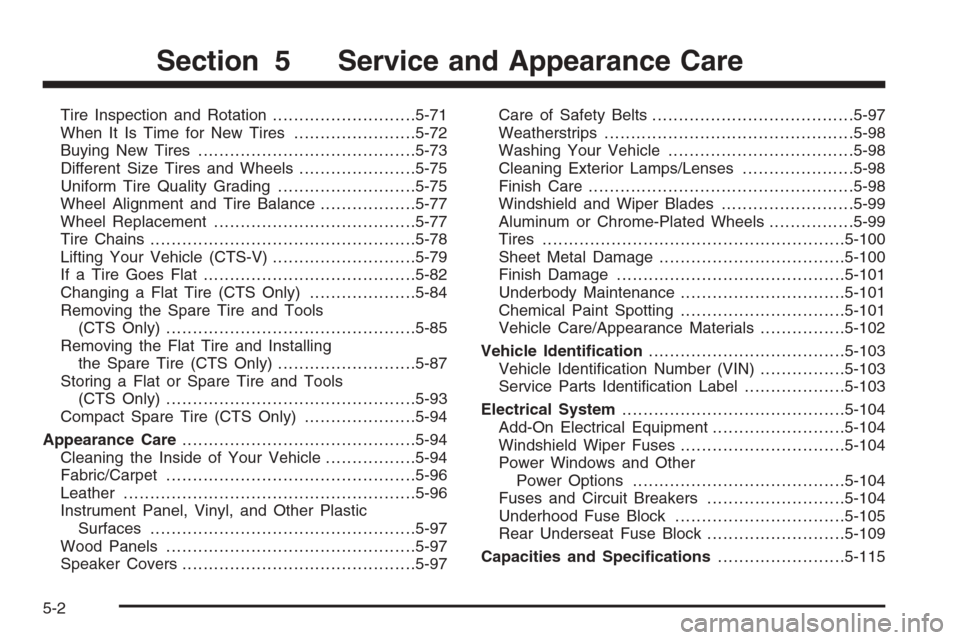
Tire Inspection and Rotation...........................5-71
When It Is Time for New Tires.......................5-72
Buying New Tires.........................................5-73
Different Size Tires and Wheels......................5-75
Uniform Tire Quality Grading..........................5-75
Wheel Alignment and Tire Balance..................5-77
Wheel Replacement......................................5-77
Tire Chains..................................................5-78
Lifting Your Vehicle (CTS-V)...........................5-79
If a Tire Goes Flat........................................5-82
Changing a Flat Tire (CTS Only)....................5-84
Removing the Spare Tire and Tools
(CTS Only)...............................................5-85
Removing the Flat Tire and Installing
the Spare Tire (CTS Only)..........................5-87
Storing a Flat or Spare Tire and Tools
(CTS Only)...............................................5-93
Compact Spare Tire (CTS Only).....................5-94
Appearance Care............................................5-94
Cleaning the Inside of Your Vehicle.................5-94
Fabric/Carpet...............................................5-96
Leather.......................................................5-96
Instrument Panel, Vinyl, and Other Plastic
Surfaces..................................................5-97
Wood Panels...............................................5-97
Speaker Covers............................................5-97Care of Safety Belts......................................5-97
Weatherstrips...............................................5-98
Washing Your Vehicle...................................5-98
Cleaning Exterior Lamps/Lenses.....................5-98
Finish Care..................................................5-98
Windshield and Wiper Blades.........................5-99
Aluminum or Chrome-Plated Wheels................5-99
Tires.........................................................5-100
Sheet Metal Damage...................................5-100
Finish Damage...........................................5-101
Underbody Maintenance...............................5-101
Chemical Paint Spotting...............................5-101
Vehicle Care/Appearance Materials................5-102
Vehicle Identi�cation.....................................5-103
Vehicle Identi�cation Number (VIN)................5-103
Service Parts Identi�cation Label...................5-103
Electrical System..........................................5-104
Add-On Electrical Equipment.........................5-104
Windshield Wiper Fuses...............................5-104
Power Windows and Other
Power Options........................................5-104
Fuses and Circuit Breakers..........................5-104
Underhood Fuse Block................................5-105
Rear Underseat Fuse Block..........................5-109
Capacities and Speci�cations........................5-115
Section 5 Service and Appearance Care
5-2
Page 278 of 442

Doing Your Own Service Work
{CAUTION:
You can be injured and your vehicle could be
damaged if you try to do service work on a
vehicle without knowing enough about it.
Be sure you have sufficient knowledge,
experience, the proper replacement parts,
and tools before you attempt any vehicle
maintenance task.
Be sure to use the proper nuts, bolts,
and other fasteners. English and metric
fasteners can be easily confused. If you
use the wrong fasteners, parts can later
break or fall off. You could be hurt.If you want to do some of your own service work,
you will want to use the proper service manual. It tells
you much more about how to service your vehicle
than this manual can. To order the proper service
manual, seeService Publications Ordering Information
on page 7-16.
Your vehicle has an airbag system. Before attempting
to do your own service work, seeServicing Your
Airbag-Equipped Vehicle on page 1-67.
You should keep a record with all parts receipts and
list the mileage and the date of any service work
you perform. SeeMaintenance Record on page 6-17.
5-4
Page 287 of 442
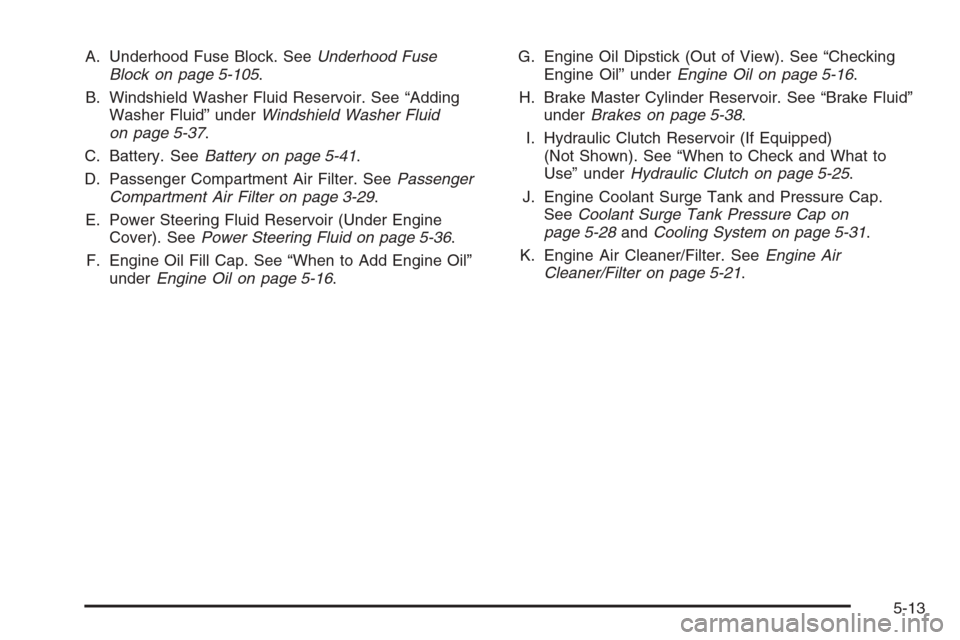
A. Underhood Fuse Block. SeeUnderhood Fuse
Block on page 5-105.
B. Windshield Washer Fluid Reservoir. See “Adding
Washer Fluid” underWindshield Washer Fluid
on page 5-37.
C. Battery. SeeBattery on page 5-41.
D. Passenger Compartment Air Filter. SeePassenger
Compartment Air Filter on page 3-29.
E. Power Steering Fluid Reservoir (Under Engine
Cover). SeePower Steering Fluid on page 5-36.
F. Engine Oil Fill Cap. See “When to Add Engine Oil”
underEngine Oil on page 5-16.G. Engine Oil Dipstick (Out of View). See “Checking
Engine Oil” underEngine Oil on page 5-16.
H. Brake Master Cylinder Reservoir. See “Brake Fluid”
underBrakes on page 5-38.
I. Hydraulic Clutch Reservoir (If Equipped)
(Not Shown). See “When to Check and What to
Use” underHydraulic Clutch on page 5-25.
J. Engine Coolant Surge Tank and Pressure Cap.
SeeCoolant Surge Tank Pressure Cap on
page 5-28andCooling System on page 5-31.
K. Engine Air Cleaner/Filter. SeeEngine Air
Cleaner/Filter on page 5-21.
5-13